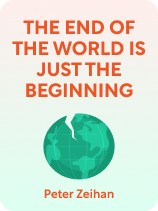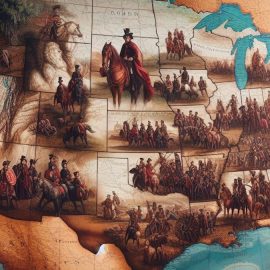

This article is an excerpt from the Shortform book guide to "The End of the World Is Just the Beginning" by Peter Zeihan. Shortform has the world's best summaries and analyses of books you should be reading.
Like this article? Sign up for a free trial here.
What’s the future of global trade? How could a breakdown in international shipping affect your daily life?
Peter Zeihan’s The End of the World Is Just the Beginning presents a sobering view of our globalized world’s fragility. He argues that demographic shifts and geopolitical changes may soon unravel the international trade system we’ve come to rely on.
Keep reading to discover Zeihan’s predictions for the coming decades and learn why he believes some countries are better positioned to weather the storm than others.
Overview of Peter Zeihan’s The End of the World Is Just the Beginning
It’s easy to envision the ways the world might end—nuclear war, mass extinction, and climate disasters may be the first that come to mind. However, according to geopolitical expert Peter Zeihan, the most pressing threat to human civilization is the impending collapse of international trade. Peter Zeihan, in The End of the World Is Just the Beginning (published in 2022), predicts that a looming demographic implosion will trigger a global trade crisis, which the United States may exacerbate if it stops using its military resources to safeguard international shipping.
The end of globalized international trade would spell worldwide economic disaster, causing turmoil and hardships that would be felt by every person on the planet. These would include higher energy costs, political instability, less access to goods and resources, and potential famine in large swaths of the planet. Unfortunately, there may be no way to avoid these problems, and while Zeihan doesn’t offer any clear-cut solutions, he writes that we can’t deal with issues of this scale without being fully aware of what’s at stake.
Zeihan is a geopolitical strategist and consultant known for his expertise in global affairs, demographics, and energy. He’s worked as a geopolitical analyst for various organizations, including the US State Department. Zeihan has written multiple books on global issues, including The Accidental Superpower (2014), The Absent Superpower (2017), and Disunited Nations (2020).
We’ll present Zeihan’s argument that the world has been living in a golden age of international trade since the end of World War II, and why that age of prosperity is about to come to an end. We’ll explain the process by which global trade and interdependence may soon unravel, and what difficulties we can expect to experience in the tumultuous decades to come.
The Golden Age (1945-2020)
Before we can speculate about the end of globalization, we need to define what it entails. According to Zeihan, globalization is the system of free and safe trade between countries, characterized by international economic competition and interdependence on a worldwide scale. Zeihan contrasts this to the prior status quo of empire-building and wars over resources, which climaxed in the first half of the 20th century before the United States changed the paradigm of international commerce.
Throughout history, geography has played a crucial role in determining a country’s survival and stability. This is why the first civilizations emerged in river valleys that were favorable for agriculture, had reliable water sources, and possessed natural defenses against invaders. As technology advanced, we harnessed new energy sources, starting with wind before moving on to coal and then oil. Zeihan explains that the countries that possessed such technological advantages could move their militaries more effectively than their rivals. They conquered their neighbors to acquire more resources, building empires as they did so.
The End of the Old World
Technological progress also increased humanity’s capacity for destruction, culminating in the two World Wars that devastated much of the industrialized world. The US, with its geographic protections and abundant natural resources, emerged from World War II as the only remaining country with a robust economy, a functioning industrial sector, and a strong military. Zeihan says that instead of asserting itself as an empire, the US used its advantage to create a new world order—one aimed at isolating and economically strangling the Soviet Union. The US offered the world a deal: Align against the Soviet Union, and in return, the US would become the world’s police to ensure that international trade could flourish—except in the Soviet bloc.
Zeihan asserts that, during this period, we’ve lived in an era of unprecedented economic growth and stability facilitated by the US’s commitment to protecting worldwide trade and transportation. As a result, many previously undeveloped countries were able to industrialize rapidly and join the global market. These formerly agrarian nations now house a growing number of their people in cities, where power, water, and food must be sourced from elsewhere. To date, that’s been comparatively easy, since for over 70 years, the US Navy has safeguarded global shipping.
International Trade
Zeihan argues that the importance of the US’s commitment to protecting international shipping can’t be overstated. Safe, cheap, and reliable shipping underpins every aspect of globalization, from importing and exporting finished products, to playing a vital role in global supply chains, access to energy, and our ability to feed the Earth’s booming population.
Even before globalization, advances such as deep-water sailing and rail travel changed the limits set on countries by geography. Sailing opened the oceans for international trade, while rail provided easy access to countries’ interiors, letting them ship farm products abroad with relative ease. However, Zeihan writes that, prior to globalization, empires generally didn’t trade with each other—trade flowed between a ruling country and its conquered vassal states while competing empires preyed on each other through the use of state-sponsored piracy. However, when the US changed this paradigm at the end of World War II by agreeing to keep the oceans safe for travel, it effectively rendered the “imperial” model of international trade defunct.
As a result, international trade boomed, with sea ports growing to accommodate the massive volume of cargo they had to handle. Since they didn’t have to defend themselves, ocean-going ships became large and slow, while transportation costs became almost negligible. Safe shipping allowed economies to flourish wherever people could produce and export goods, leading to rapid industrialization and dramatically higher standards of living. Zeihan says an unintended consequence of this system was that different countries could now specialize in producing whatever goods they excelled at, regardless of whether those products met their own citizens’ needs. Instead, they could simply import what they needed and export for profits.
Manufacturing
Zeihan writes that modern shipping has made it possible for countries to specialize not only in producing specific types of products, but also in making specific parts of products, rather than the entire product itself. In this way, globalization has led to a worldwide manufacturing chain where each country serves as a link in the process. Meanwhile, businesses also outsource product design, sales, and distribution to even more countries, locating each task in the part of the world where it can be accomplished at the lowest cost.
While globalized manufacturing makes products and services cheaper for businesses and consumers, this system is inherently brittle. Zeihan points out that long supply chains are extremely vulnerable to natural disasters, political turmoil, and war. If any part of the chain is interfered with, then everyone suffers the impact—suppliers of raw materials can’t reach their markets, those in the middle don’t have products to assemble, and consumers can’t buy the products they need.
Protecting the Oil
Oil is the fuel that runs globalization, and without it, the system won’t function. However, oil is only found in certain locations and must be transported like any other commodity. Before World War II, every country guarded its private oil supply, but afterward, the US opened up the oil trade as part of its efforts to isolate the Soviet Union. Zeihan writes that any non-communist country with oil could enter the business and expect the US to protect its exports. The US’s own dependence on foreign oil gave it further motivation to keep oil traffic flowing, as seen in the first Gulf War. It wasn’t until the advent of “fracking”—drilling for hard-to-reach shale oil—that the US became oil-independent once again, reducing its need to fight for foreign oil.
Feeding the World
Hand-in-hand with advances in trade, globalization has revolutionized agriculture and worldwide food distribution. Industrial farming has increased the productivity of fertile land, which when combined with reliable transportation and refrigeration, has enabled places that previously couldn’t support large populations to do so. It has also allowed cities to expand, as they no longer need to be adjacent to their food supply. Zeihan says that as a result, while hunger still exists, it’s far less prevalent than it would be without globalization.
Global shipping has also let us reorganize where food is grown. Instead of using farms to feed their local communities, most agricultural locations now produce crops that make the most profit and ship them to wherever the demand for them is highest. We now have increasingly specialized agriculture, where countries no longer grow the food they need, but instead grow the food they can sell, expecting that they can import their own food from other farms thousands of miles away. Zeihan warns that while this system provides the world with a level of food diversity never seen before, it relies heavily on safe, reliable shipping. If the shipping network falls apart, so does the distribution of food.
Globalization Falls Apart
All good things come to an end, and according to Zeihan, globalization’s days are just about over. This is because the pillars that support it—cheap energy, low-risk transportation, and stable supply lines for manufacturing and food—are crumbling.
The fall of the Soviet Union marked a turning point for globalization, as the US’s primary reason for maintaining international security disappeared. Although the US hasn’t completely abandoned its role as global protector, it has become increasingly difficult to justify this position to itself and its citizens. While the relaxed global tensions following the Cold War were a boon for most countries—resulting in a free-for-all of worldwide economic expansion—Zeihan argues that this era was the peak of globalization, and its gains aren’t sustainable because of their overdependence on the US ensuring peaceful global trade.
Consider: Many countries are now so heavily specialized in producing particular goods and services for export that most parts of the world can’t provide for themselves if global trade is disrupted. This is Zeihan’s nightmare scenario—that a major blow to international trade will start a chain reaction that topples society on a global scale. Zeihan predicts a sequence of events that will pull the world’s globalized economy apart—the population in key regions will decline, the world will break up into regional factions, and it will become more difficult to transport oil and food where they need to go.
Demographic Collapse
Zeihan suggests that declining populations in the developed world will trigger economic crises around the globe. The process began when more people moved from rural areas into cities—space for families became smaller, birth rates slowly dropped, and medical advances extended people’s lives. The combination of longer lives and fewer children led to our present-day aging population, and though people with fewer children to provide for can increase their savings and investments, boosting the capital fueling economic growth, there are fewer young people to reap the benefits. In short, economic growth isn’t sustainable if the population dwindles, and extended lifespans can only offset a reduction in birth rates for a limited time.
As more people retire from the workforce, there are fewer young workers to replace them, and as the larger, older generation passes away, the precipitous population drop that follows will come as an economic blow to the system. Zeihan argues that China in particular is at the highest risk for a demographic implosion due to its decades-long one-child-per-family policy, and when the Chinese workforce disappears, its economy will crack under the strain. Since China and other East Asian countries are vital to globalized manufacturing, the world will feel the brunt as the number of Asian workers decreases and the cost of their labor goes up.
Zeihan says that only a few countries, including the US, have industrialized and urbanized without seeing a drop in population. While the US will feel a demographic shock as the Baby Boomers (born 1946-1964) retire, the Millennial generation (born 1981-1996) is large enough to potentially carry the country through the 2040s. However, other countries face population reductions that may prove lethal to their economies. In tandem with the workforce reduction, people who retire draw their money out of investments, which decreases the economy’s credit supply, making it harder to fund new enterprises. Moreover, a shrinking labor force also means a smaller tax base, leaving governments strapped for cash to spend on public services.

———End of Preview———
Like what you just read? Read the rest of the world's best book summary and analysis of Peter Zeihan's "The End of the World Is Just the Beginning" at Shortform.
Here's what you'll find in our full The End of the World Is Just the Beginning summary:
- Why the golden age of international trade is about to end
- Why the collapse of international trade is the biggest threat to civilization
- How to prepare for tumultuous decades to come






